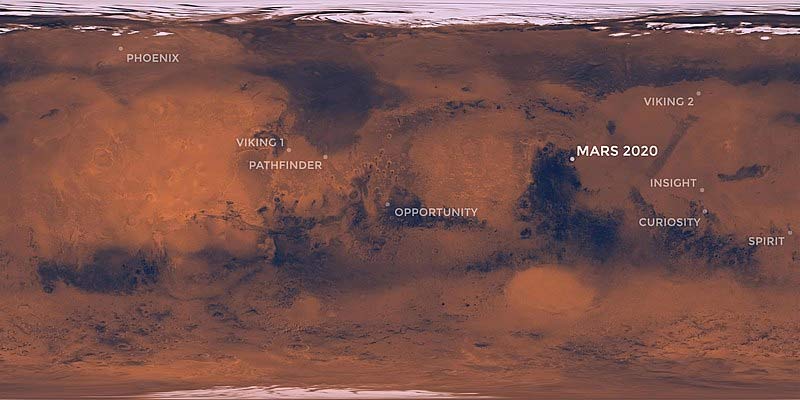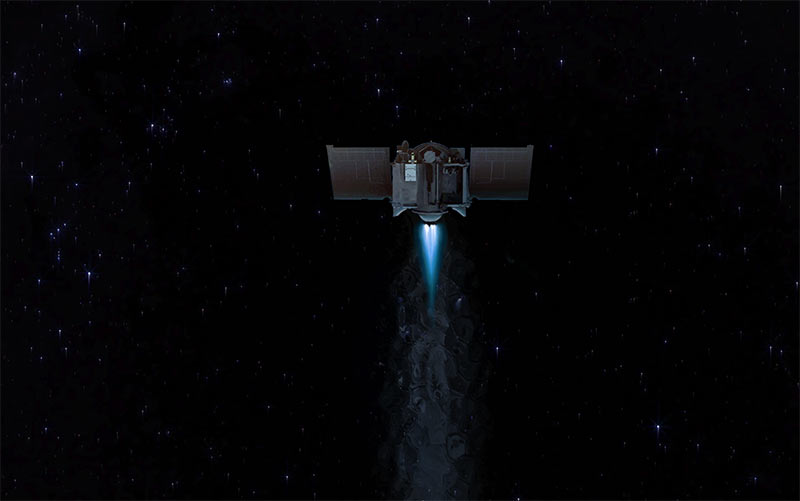Space Exploration Events Happening in 2021
Cover Image Credits: Credits: NASA/Goddard/University of Arizona
The year 2021 will record a number of important events in space exploration. Mars in particular will be the target of 3 important mission, one from NASA (the Perseverance rover) and other 2 missions which will represent an absolute first: the Hope Probe Arab's first interplanetary mission; and Tianwen-1, the first Chinese lander on the Red Planet and actually the first Mars rover not operated by NASA.
Hopefully 2021 will also see to the long awaited launch of the James Webb Space Telescope, scheduled onOctober 31. Here is the list of key events:
- February 9: Hope Emirates Mars Mission enters Mars orbit
- February 18: Mars Perseverance Rover Landing
- May 10: OSIRIS-REx Departure from Bennu
- May: Tianwen-1 Rover Landing on Mars
- October 31: James Webb Telescope Launch
Read below for more detailed information about these events.
February 9: Hope Emirates Mars Mission enters Mars orbit
The Hope Probe is the first Arab interplanetary mission. Its scientific objective is to deeply study Mars atmosphere and related phenomena, in particular the dynamic related to the dispersion in space of gases like Oxygen and Hydrogen during the alternating Mars seasons. The first milestone of the mission is on February 9, when the probe will perform its insertion into the Martian orbit after a 7 months trip.
February 18: Mars Perseverance Landing
The Mars Perseverance Rover mission was launched on July 30, 2020 from Cape Canaveral Air Force Station in Florida. It's key objective is to explore Mars and seek signals of ancient life. In order to do that, the rover will collect and analyze samples of the Red Planet's surface, as well as collect samples to be returned to Earth through future missions. Additionally, the rover will conduct some tests on technologies that might be employed in future human explorations of Mars. For instance one experiment will test the production of oxygen, a technology that will be key in order to support life of the future explorers during long stays on the planet.
Landing
The rover is expected to land on the Red Planet on February 18, 2021. The exact location will be the Jezero Crater, a 49 kilometers wide crater which is believed to be an ancient Martian lake, given the morphology of clay deposits which clearly resemble river deltas.
The image below shows the landing location of Perseverance, with respect to the landing location of other previous missions.

The image below, in false color, is a high resolution image of Jezero Crater which shows the area where Perseverance will land and the evident formations similar to a river delta.

Landing Perseverance on Mars will require several steps of highly coordinated maneuvers, supported by extremely sophisticated technologies. It is not a case that the process of landing probes on Mars is known as the "seven minutes of terror"! The image below (original on NASA website) is a representation of the different phases of the descent and landing, which will take about 410 seconds (6 minutes and 50 seconds) from when the lander will enter the atmosphere of Mars to the instant when the rover will land on the planet's surface.

NASA is hopeful to get signals back to Earth confirming a successful landing on February 18, 2021 at 20:55 UTC.
How to watch and follow the landing of Mars Perseverance
There will be plenty of options to follow and watch the event of Perseverance landing on Mars, we recommend this great article by Emily Lakdawalla, which provides detailed information.
May 10: OSIRIS-REx Departure from Bennu
NASA's OSIRIS-REx mission was launched on September 8, 2016 with the objective to land a probe on asteroid Bennu, in order to explore it and collect samples of the asteroid's surface to be sent back to Earth.
During its permanence on Bennu, OSIRIS-REx collected about 60 grams of the asteroid's surface material and, based on the planned schedule, on on May 10 2021 the probe will take off and start its journey back to Earth. It's landing is expected to happen on September 24, 2023.

May: Tianwen-1 Landing on Mars
After entering Mars orbit on February 10 2021, the Chinese spacecraft Tianwen-1 is expected to land its rover on the Red Planet's surface in May 2021. Tianwen-1 is a very ambitious mission which is positioning China Space Agency at the forefront of the Solar System exploration. Until now, in fact, only NASA has been able to land and operate rovers on the surface of Mars.
Among the scientific objectives of Tianwen-1 there is the detection of existing water using radar technologies. Such a detection has been already performed by orbiting probes, and this will be the first time when this will be done from the planet's surface. Additionally, the mission includes several instruments to analyze Mars surface and will will perform studies to pave the way for future missions aimed to collect samples and return them back to Earth.

October 31: James Webb Telescope Launch
The launch of the James Webb Space Telescope (JWST) is considered to be a fundamental milestone in deep space exploration. Given its observational capabilities, it will help us will reach distances that are inaccessible using todays even most advanced instruments and get a better understanding of the first ages of our Universe, including, for instance, understanding how the first galaxies formed. The Wikipedia article about the JWST provides many detailed information about the telescope itself and its scientific objectives.

The story of the JWST is a long one. Initially planned for launch in 2007, the project suffered multiple delays and at least one major re-design in 2005. The currently planned launch window is on October 31.

